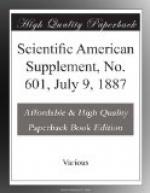[Illustration: Fig. 3.]
Quest.—Why do they give better results when run slow?
Ans.—Partly because of their great weight over ordinary belting, also their grip power is stronger when run slow. No belt is superior to them for slow, hard working machinery.
Quest.—Are they more expensive than ordinary flat belting?
Ans.—Not when compared to the work they can accomplish.
[Illustration]
Quest.—Can they be run in wet places, such as mines, etc.?
Ans.—Yes; by waterproofing the leather, no cement being used as in flat belts. The links can be made positively waterproof. We have furnished paper mills, tanneries and bleacheries, and other exposed places with waterproof link belts, and all have been entirely satisfactory so far.
Quest.—Can they be run on ordinary flat pulleys?
Ans.—Yes; our “American joint” link belt can be run on any straight or rounded pulley, whether made of iron, paper, or wood, and being all endless they run much smoother than other belting.
[Illustration: ENGLISH HINGE JOINT:]
Quest.—How are they made endless?
Ans.—By a very simple process (see illustration), and takes almost less time than lacing a flat belt. All that is necessary is to take both ends and interlock the links, then pass the bolt through and rivet it, and when you wish to shorten the belt proceed likewise: File off the end of the bolt and take out, or add rows of links at pleasure and rejoin it again.
[Illustration: Fig. 4 is a complete round link belt.]
Quest.—What is the relative strength of a link belt compared to flat belting?
Ans.—Nothing definite has yet been ascertained. We are preparing a table showing results, and so far we can report that they can stand about twice the strain of double flat belts. A four inch link belt one inch thick is able to do the work of an eight inch flat double belt.
[Illustration: Fig. 5 is a side view.]
Quest.—Explain the advantage of your American joint over the English hinge.
Ans.—The American joint gives a perfect unbroken surface of entire width of belt, whereas the English hinge joint makes two half widths, and whenever a sudden change of power occurs and the belt runs half way off the pulley, it will catch at the edge and tear everything to pieces.
[Illustration: Fig. 6 is an end view.]
Quest.—Have you a table or schedule of their weight per square foot?
Ans.—Yes. The following is as near as we can estimate the weight of leather link belting per square foot:
1 inch thick, about 5 lb. per sq. ft. 7/8 " " " 41/2 " " " 3/4 " " " 4 " " " 5/8 " " " 31/2 " " "
Upon motion a vote of thanks was passed, and the paper read ordered to be printed.
[Illustration: Fig. 7 is a single link.]




